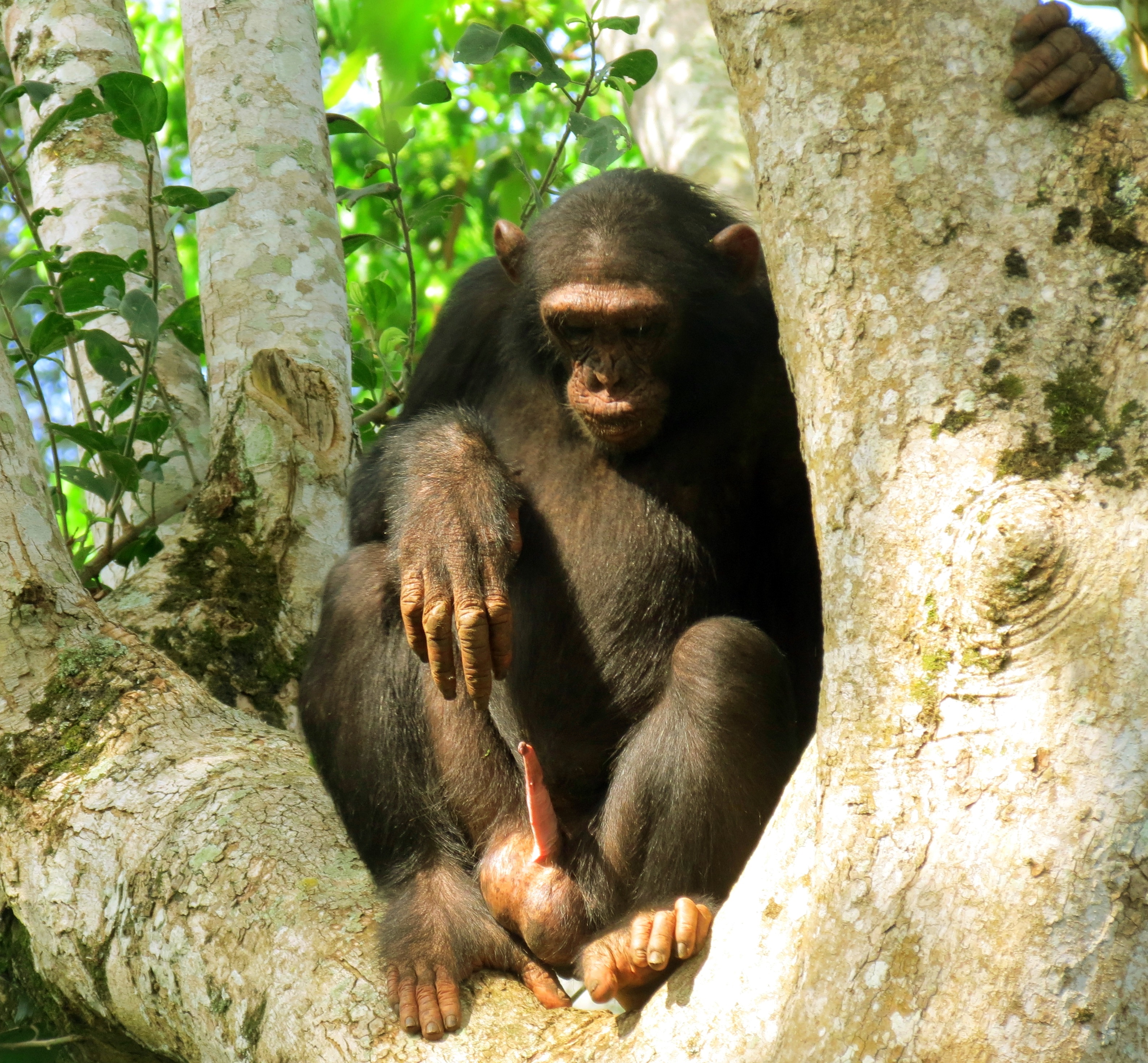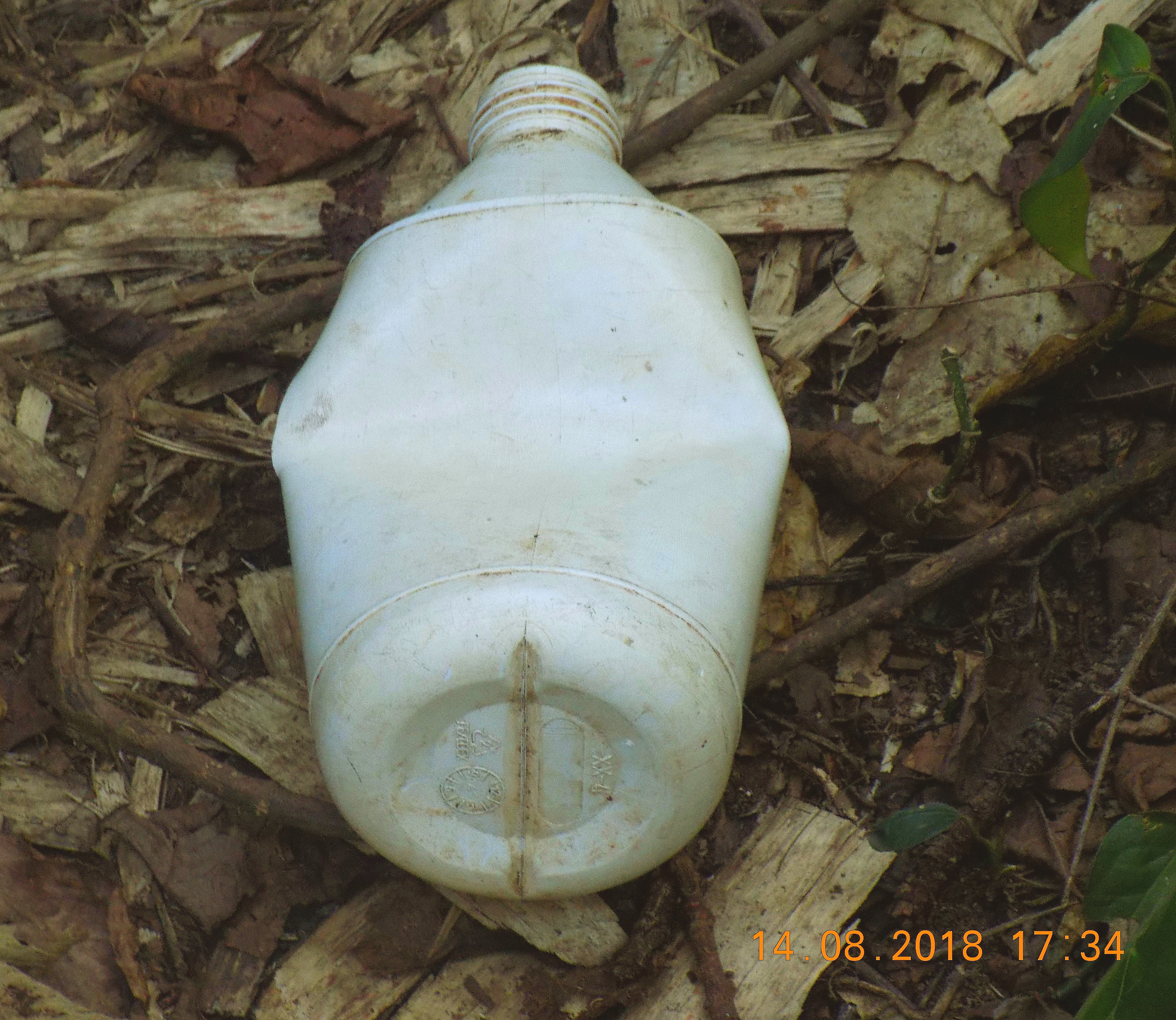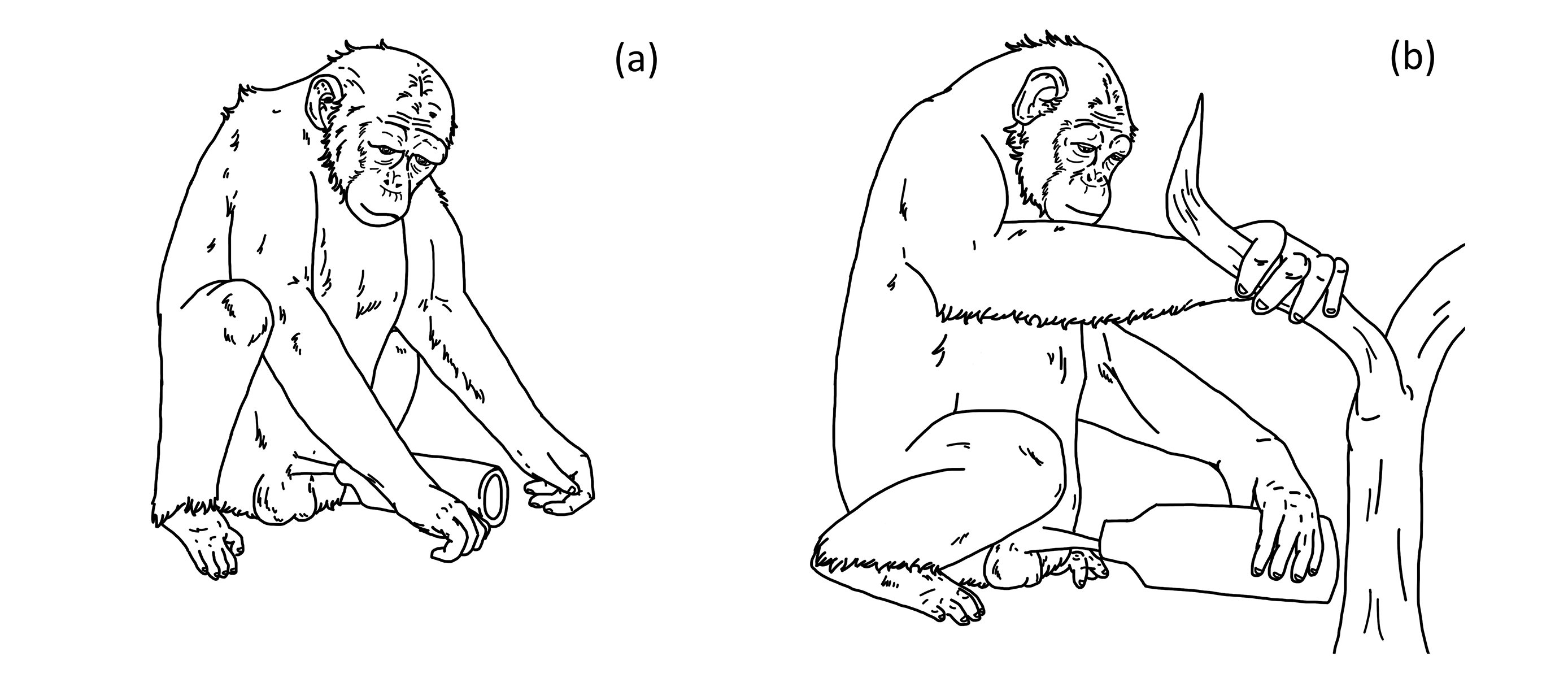|
<NOTE>
Published online (July 12, 2021)
Use of a novel human object as a masturbatory tool by a wild male chimpanzee at Bulindi, Uganda
Matthew R. McLennan1,2,3
1 Bulindi Chimpanzee and Community Project, Hoima, Uganda 2 Faculty of Social Sciences, Oxford Brookes University, Oxford, UK 3 Centre for Ecology and Conservation, University of Exeter, Cornwall, UK 4 Animal Behaviour and Cognition, Utrecht University, Utrecht, The Netherlands INTRODUCTION Besides humans, self-stimulation of the genitalia (masturbation) has been documented in many primate species (Dixson 2012; Thomsen & Sommer 2017). Although masturbation by captive nonhuman primates is sometimes considered abnormal or, at least, undesirable behaviour (e.g., Mallapur & Choudhury 2003), masturbation also occurs under natural conditions and may represent a phylogenetically ancient and widespread trait in primates (Thomsen & Sommer 2017). Several studies have reported masturbation in wild male primates living in multimale–multifemale groups where sperm competition occurs (e.g., Temminck’s red colobus, Piliocolobus badius temminckii; Starin 2004; Japanese macaque, Macaca fuscata; Thomsen & Soltis 2004; rhesus macaque, Macaca mulatta; Dubuc et al. 2013). While the hypothesis that male masturbation functions to increase sperm quality (Baker & Bellis 1993) received support in one study of Japanese macaques (Thomsen & Soltis 2004), masturbation leading to ejaculation was observed rather rarely in most reports, suggesting alternative explanations require consideration (Starin 2004; Dubuc et al. 2013). In chimpanzees, masturbation occurs commonly in captive settings where it has been linked to restricted rearing, which can impede development of speciestypical social and sexual behaviour (Kollar et al. 1968; Rogers & Davenport 1969; Lopresti-Goodman et al. 2013). Masturbation by captive chimpanzees is performed by hand, foot or mouth, against a cage wall or screen, or sometimes using a manipulable object (Shefferly & Fritz 1992). In the wild, object-assisted masturbation occurs in male long-tailed macaques (Macaca fascicularis), which stimulate their genitals using stones (Cenni et al. 2020). Such self-directed employment of a manipulable object meets the criteria of an animal ‘tool’ (Shumaker et al. 2011). In contrast to captivity, masturbation appears to be rare among male chimpanzees in the wild. Male chimpanzees of all ages at Gombe and Mahale, Tanzania, manipulated (or ‘fumbled’ or ‘fiddled’ with) their erect penises occasionally, but this was never observed to lead to ejaculation (van Lawick-Goodall 1968; Nishida 1997). Recently, Nakamura (2018) described an infant chimpanzee at Mahale ‘copulating’ with a discarded fruit wadge, which was likened to a ‘sex toy’. Besides this, there seem to be no other reports of wild male chimpanzees using manipulable objects as tools in sexual behaviour. We observed a wild subadult male chimpanzee at Bulindi, Uganda, using a novel human object—a discarded plastic bottle—as a masturbatory tool. While anecdotal (Ramsay & Teichroeb 2019), this unusual observation raises questions about the function of masturbation in male chimpanzees, and contributes to an understanding of the range in behavioural responses of wild apes to novel objects. METHODS Study site Chimpanzees Pan troglodytes schweinfurthii in Bulindi (1°29′N, 31°28′E) were first studied during 2006–2007 (McLennan & Hill 2010) and subsequently from 2012 to the present. They inhabit a human-modified environment comprising fragments of riverine forest amidst farmland and villages (McLennan et al. 2020). The chimpanzees feed habitually on agricultural crops and encounter local people on a daily basis (McLennan et al. 2019a; 2020). They also encounter discarded human objects, including plastic bottles and other litter items. The Bulindi chimpanzees use leaf or stick tools in various contexts including foraging (McLennan 2011; McLennan et al. 2019b) and hygiene. For example, males sometimes use leaf tools as napkins to wipe their penises after mating (unpubl. data). Bulindi males also handle or inspect their erect penises occasionally (Figure 1), typically after copulation or when females with anogenital swellings are nearby. This behaviour is not accompanied by pelvic thrusts, as occurs during copulation, and has not been observed to result in ejaculation. Thus, it appears similar to penis ‘fumbling’ described at other sites (van Lawick-Goodall 1968; Nishida 1997). During the present observation in August 2018, chimpanzees were habituated and observable at distances of ≤10 m (Cibot et al. 2019). Community size was 19 including 3 adult and 3 subadult males, 5 adult and 1 subadult females, and 7 immature individuals. The subject of this report is a subadult male named ‘Araali’. In 2018, Araali was estimated to be 9-years old (Figure 1). He had descended testicles, an adult-sized penis, and displayed rhythmic contractions during mating, suggesting he was sexually mature and able to ejaculate. 
OBSERVATIONS At midday on 13th August 2018, we followed a party of 11 chimpanzees to a Lantana camara thicket. (L. camara is an invasive weed that forms dense thickets that the chimpanzees use for resting and shade). The party included the alpha male and 3 adult females, none of whom had anogenital swellings. We could hear a chimpanzee manipulating a plastic object under the Lantana. At 12:10 h we approached and observed Araali in possession of a medium-sized plastic bottle, which he was ‘copulating’ with. It is unclear how long he was engaged in this behaviour prior to our approach. The bottle was approximately 1–1.5 L, empty, and without a label or cap (Figure 2); field assistants suggested it was a discarded herbicide bottle of the kind used by local farmers. 
We made a 1-min video of Araali’s behaviour (Video1). At the start of the recording, Araali had inserted his erect penis into the bottle’s open top. For 25 sec he made pelvic thrusting movements into the bottle, which he had positioned flat on the ground in front of him (Figure 3a). Once, he repositioned the bottle after his penis came out. At times he showed a relaxed open-mouth expression (or ‘play face’; van Lawick-Goodall 1968). After 30 sec, Araali inspected his erect penis manually before sniffing his fingers. Lifting the bottle, he peered into the open top. He then reinserted his penis into the bottle, which he held in position with one hand while holding a branch with the other (Figure 3b). For the remaining 8 sec of the recording, Araali sat with a play face, apparently with his penis still inside the bottle. Shortly after the recording ended, Araali walked away leaving the bottle behind. It was collected immediately by a juvenile male who, with other youngsters, played with it until we left the chimpanzees at 12:35 h. Therefore, we could not determine if Araali ejaculated into the bottle during the observation. We located the bottle the following evening; however, we did not collect it to test for traces of semen. Video 1 
DISCUSSION We observed a wild sexually-mature chimpanzee using a human object as a tool in autoerotic behaviour, i.e. as a ‘sex toy’. Our observation shares similarities with a previous report of an infant male at Mahale, which used a fruit wadge as a masturbation tool (Nakamura 2018). Araali’s tool-assisted masturbation was further distinct from ordinary penis handling or ‘fumbling’ by male chimpanzees at Bulindi, which does not involve pelvic thrusting. While we cannot exclude the possibility that Araali ejaculated into the bottle, it seems doubtful: intromission in sexually-mature males is ordinarily short (mean: 7 sec; Nishida 1997), whereas Araali thrust into the bottle for over 20 seconds. How should Araali’s masturbatory behaviour be explained? Male primates in multimale–multifemale social groups, including chimpanzees, may not always be able to copulate because of competition with higher-ranking males. Thus, masturbation could improve semen quality by discarding old sperm (Baker & Bellis 1993). However, no sexually receptive females were present during the observation, making such an adaptive explanation unlikely. In multimale–multifemale groups where sperm competition occurs, males might have neuroendocrine specializations for enhanced sexual arousal and copulatory performance; thus, masturbation could provide a sexual outlet for subordinate males with little or no access to receptive females (Dixson 2012). Although Araali occasionally mated with receptive females, he was subordinate to three adult males. In particular, the alpha male successfully monopolised receptive females (McCarthy et al. 2020). Nevertheless, given the rarity of reports of male masturbation in wild chimpanzees, including an absence of reports of masturbation leading to ejaculation (and the lack of evidence for ejaculation in our observation), this ultimate explanation for Araali’s behaviour is also doubtful. Wild great apes including chimpanzees were reported to show generally indifferent or neophobic responses to novel objects (Forss et al. 2015; Kalan et al. 2019). However, where chimpanzees and other wild primates encounter human artefacts frequently, as at Bulindi, novel human items can elicit interest, leading to object handling and, potentially, novel behaviours (cf. van de Waal & Bshary 2010; le Roux et al. 2019). Young chimpanzees at Mahale manipulated and played with long-abandoned clay pots (Matsusaka 2012) and attempted to touch or inspect human belongings (Matsusaka et al. 2015). Similarly, the enthusiastic play with the bottle by immature chimpanzees in Bulindi is consistent with previous findings that younger apes are more curious of objects than adults (Ramsey & McGrew 2005; Kalan et al. 2019). Araali’s masturbatory behaviour most likely resulted from his motivation to inspect and play with a novel human object. Male chimpanzees exhibit penile erections in various contexts besides sexual arousal, such as food excitement and during some social interactions including play (pers. observ.). The physical properties of the open bottle presumably elicited Araali’s autoerotic response, suggesting he recognized its suitability for that purpose. Considering he exhibited a play face while ‘copulating’ with the bottle indicates his masturbatory behaviour was ‘pleasurable’ or ‘fun’. ACKNOWLEDGEMENTS We thank the Uganda National Council for Science and Technology and Uganda Wildlife Authority for permission to study chimpanzees in Bulindi. For field assistance, we thank John-Mary Baruzaliire and Tom Sabiiti. Conservation and research at Bulindi was supported by Blair Drummond Safari Park, Born Free Foundation, Friends of Chimps and Jane Goodall Institute-Switzerland. We thank Kimberley Hockings and the reviewers for helpful feedback on previous versions of the manuscript. We dedicate this article in loving memory of Jackie Rohen who was devoted to conserving the chimpanzees of Bulindi. REFERENCES Baker RR, Bellis MA 1993. Human sperm competition: Ejaculate adjustment by males and the function of masturbation. Anim Behav 46:861–885. https://doi.org/10.1006/anbe.1993.1271 Cenni C, Casarrubea M, Gunst N, et al. 2020. Inferring functional patterns of tool use behavior from the temporal structure of object play sequences in a non-human primate species. Physiol Behav 222:112938. https://doi.org/10.1016/j.physbeh.2020.112938 Cibot M, McCarthy MS, Lester JD, et al. 2019. Infant carrying by a wild chimpanzee father at Bulindi, Uganda. Primates 60:333–338. https://doi.org/10.1007/s10329-019-00726-z Dixson AF 2012. Primate Sexuality: Comparative Studies of the Prosimians, Monkeys, Apes, and Humans. Oxford University Press, New York. Dubuc C, Coyne SP, Maestripieri D 2013. Effect of mating activity and dominance rank on male masturbation among free-ranging male rhesus macaques. Ethology 119:1006–1013. https://doi.org/10.1111/eth.12146 Forss SIF, Schuppli C, Haiden D, Zweifel N, van Schaik CP 2015. Contrasting responses to novelty by wild and captive orangutans. Am J Primatol 77:1109–1121. https://doi.org/10.1002/ajp.22445 Kalan AK, Hohmann G, Arandjelovic M, et al. 2019. Novelty responses of wild African apes to camera traps. Curr Biol 29:1211–1217. https://doi.org/10.1016/j.cub.2019.02.024 Kollar EJ, Beckwith WC, Edgerton RB 1968. Sexual behavior of the ARL colony chimpanzees. J Nerv Ment Dis 147:444–459. https://doi.org/10.1097/00005053-196811000-00002 le Roux A, Mathibane N, Nowak K 2019. Wild samango monkeys, Cercopithecus mitis, balance risk and opportunity to interact with novel objects in village gardens. Int J Primatol 40:661–670. https://doi.org/10.1007/s10764-019-00113-x Lopresti-Goodman SM, Kameka M, Dube A 2013. Stereotypical behaviors in chimpanzees rescued from the African bushmeat and pet trade. Behav Sci 3:1–20. https://doi.org/10.3390/bs3010001 Mallapur A, Choudhury BC 2003. Behavioral abnormalities in captive non-human primates. J Appl Anim Welf Sci 6:275–284. https://doi.org/10.1207/s15327604jaws0604_2 Matsusaka T 2012. Playful drumming by immature wild chimpanzees at Mahale: Do they enjoy making sounds? Pan Afr News 19:23–25. https://doi.org/10.5134/168177 Matsusaka T, Shimada M, Nakamura M 2015. Diversity of play. In: Mahale Chimpanzees: 50 Years of Research. Nakamura M, Hosaka K, Itoh N, Zamma K (eds), Cambridge University Press, Cambridge, pp. 544–555. McCarthy MS, Lester JD, Cibot M, Vigilant L, McLennan MR 2020. Atypically high reproductive skew in a small wild chimpanzee community in a human-dominated landscape. Folia Primatol 91:688–696. https://doi.org/10.1159/000508609 McLennan MR 2011. Tool-use to obtain honey by chimpanzees at Bulindi: New record from Uganda. Primates 52:315–322. https://doi.org/10.1007/s10329-011-0254-6 McLennan MR, Hill CM 2010. Chimpanzee responses to researchers in a disturbed forest–farm mosaic at Bulindi, western Uganda. Am J Primatol 72:907–918. https://doi.org/10.1002/ajp.20839 McLennan MR, Howell CP, Bardi M, Heistermann M 2019a. Are human-dominated landscapes stressful for wild chimpanzees (Pan troglodytes)? Biol Conserv 233:73–82. https://doi.org/10.1016/j.biocon.2019.02.028 McLennan MR, Rohen J, Satsias Z, Sabiiti T, Baruzaliire J-M, Cibot M 2019b. ‘Customary’ use of stick tools by chimpanzees in Bulindi, Uganda: Update and analysis of digging techniques from behavioural observations. Rev Primatol 10. https://doi.org/10.4000/primatologie.6706 McLennan MR, Lorenti GA, Sabiiti T, Bardi M 2020. Forest fragments become farmland: Dietary response of wild chimpanzees (Pan troglodytes) to fast-changing anthropogenic landscapes. Am J Primatol 82:e23090. https://doi.org/10.1002/ajp.23090 Nakamura M 2018. Masturbation with a tool by an infant male chimpanzee. Pan Afr News 25:2–4. https://doi.org/10.5134/233027 Nishida T 1997. Sexual behavior of adult male chimpanzees of the Mahale Mountains National Park, Tanzania. Primates 38:379–398. https://doi.org/10.1007/BF02381879 Ramsay MS, Teichroeb JA 2019. Anecdotes in primatology: Temporal trends, anthropocentrism, and hierarchies of knowledge. Am Anthropol 121:680–693. https://doi.org/10.1111/aman.13295 Ramsey JK, McGrew WC 2005. Object play in great apes. In: The Nature of Play: Great Apes and Humans. Pellegrini AD, Smith PK (eds), Guilford Press, New York, pp. 89–112. Rogers CM, Davenport RK 1969. Effects of restricted rearing on sexual behavior of chimpanzees. Dev Psychol 1:200–204. https://doi.org/10.1037/h0027319 Shefferly N, Fritz P 1992. Male chimpanzee behavior in relation to female ano-genital swelling. Am J Primatol 26:119–131. https://doi.org/10.1002/ajp.1350260206 Shumaker RW, Walkup KR, Beck BB 2011. Animal Tool Behavior: The Use and Manufacture of Tools by Animals. JHU Press, Baltimore MD. Starin ED 2004. Masturbation observations in Temminck’s red colobus. Folia Primatol 75:114–117. https://doi.org/10.1159/000076273 Thomsen R, Soltis J 2004. Male masturbation in free-ranging Japanese macaques. Int J Primatol 25:1033–1041. https://doi.org/10.1023/B:IJOP.0000043350.75897.89 Thomsen R, Sommer V 2017. Masturbation. In: The International Encyclopedia of Primatology. Fuentes AN (ed), Wiley-Blackwell, Hoboken. https://doi.org/10.1002/9781119179313.wbprim0293 van de Waal E, Bshary R 2010. Contact with human facilities appears to enhance technical skills in wild vervet monkeys (Chlorocebus aethiops). Folia Primatol 81:282–291. https://doi.org/10.1159/000322628 van Lawick-Goodall J 1968. The behaviour of free-living chimpanzees in the Gombe Stream Reserve. Anim Behav Monogr 1:161–311. https://doi.org/10.1016/S0066-1856(68)80003-2 Received: 9 May 2021 Accepted: 21 June 2021 Back to Contents |